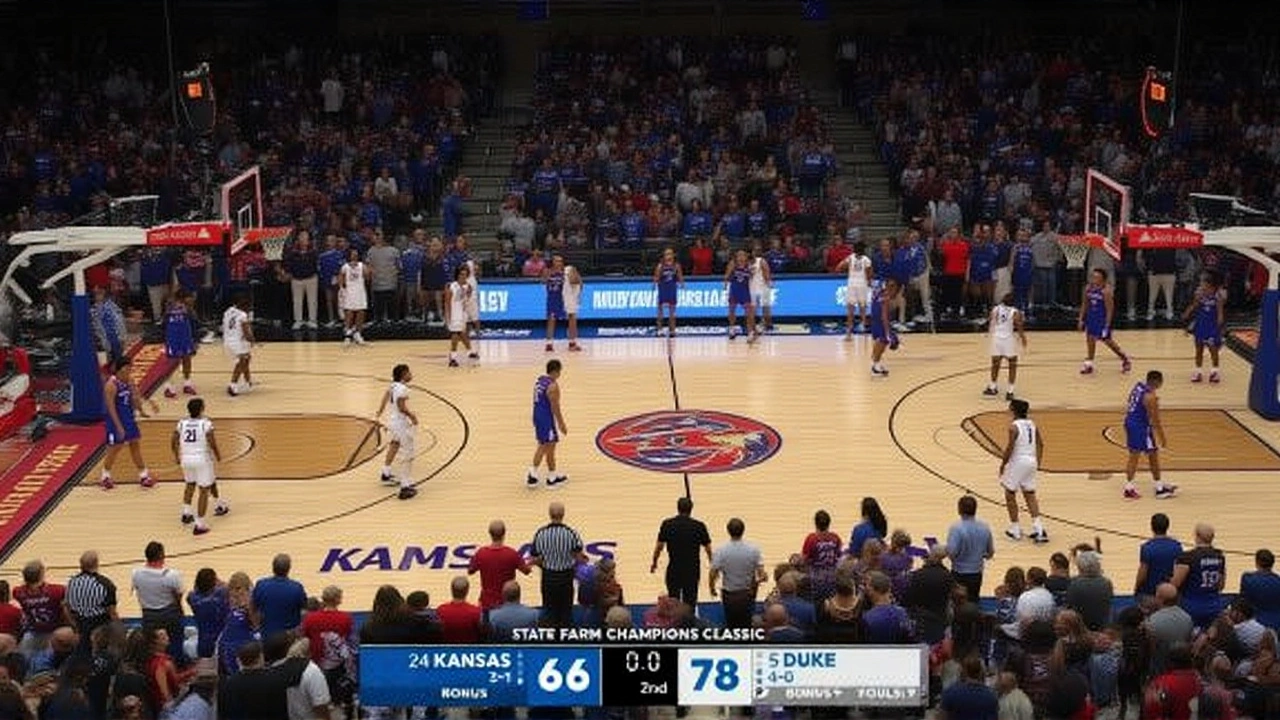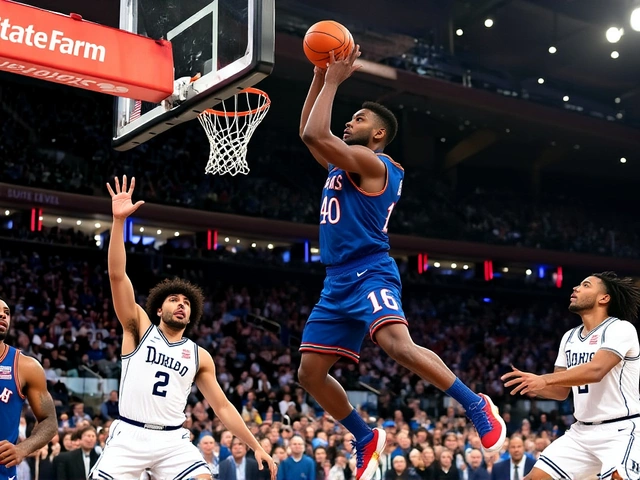On Tuesday, November 18, 2025, the Duke Blue Devils didn’t just beat the Kansas Jayhawks—they outlasted them, outsmarted them, and ultimately shut them down when it mattered most. The 78-66 win at Madison Square Garden in New York City wasn’t pretty, but it was textbook Duke basketball: disciplined, physical, and relentless. This wasn’t a blowout. It was a battle. And Duke, now 5-0 on the season, showed they can win ugly—and still dominate.
A First Half Turnaround Built on Defense
Kansas came out firing. With star center Flory Bidunga dominating early, the Jayhawks led 26-21 with 6:40 left in the half. But then everything flipped. Bidunga picked up his second foul—and the floodgates opened for Duke. The Blue Devils went on a 17-5 run to close the half, holding Kansas to a brutal 2-of-13 shooting over the final 8:24. It wasn’t luck. It was pressure. Duke’s defense forced Kansas into rushed shots, bad passes, and turnovers. And when sophomore guard Isaiah Evans buried a deep three as the buzzer sounded, the scoreboard read 41-33. The crowd gasped. Kansas looked stunned.Foul Trouble Dooms Kansas
The story wasn’t just about Duke’s offense. It was about Kansas’s unraveling. All five Jayhawks starters picked up at least one foul in the first half. Three had two. Bidunga, who averages nearly 14 points and 8 rebounds per game, sat for over 10 minutes of the first half. He returned in the second, but by the time he picked up his fourth foul with 7:12 left, the damage was done. He fouled out with 3:12 to go. Then came Bryson Tiller, Kansas’s starting guard, who followed suit with his fifth foul just 3:04 left. That left Kansas with two healthy guards and no real playmaker. No rhythm. No hope.The Boozer Twins and the Freshman Factor
While Kansas struggled, Duke’s freshmen carried the load. Twin forwards Cameron Boozer and Cayden Boozer combined for 32 points and 18 rebounds. Cameron, the more heralded recruit, posted a double-double with 18 and 10. But it was Cayden who made the game-sealing plays. He scored seven straight points in a five-minute stretch late in the second half, including a tough turnaround jumper over two defenders that pushed Duke’s lead to 70-64. Meanwhile, freshman center Patrick Ngongba was perfect—4-for-4 from the field, 13 points, no misses. And Dame Sarr hit a corner three that stretched the lead to 51-41, a shot that felt like a dagger.
The Missing Piece: Darryn Peterson
But here’s the twist no one talked about enough: Kansas was missing its most important player. Darryn Peterson, the nation’s top-ranked high school recruit and projected No. 1 pick in the 2026 NBA Draft, sat out his third straight game with a hamstring injury. He didn’t just miss shots—he missed leadership, pace, and the kind of offensive spark that could’ve broken Duke’s defensive rhythm. Coach Bill Self said after the Princeton win that Peterson would be out “for the immediate future.” That’s not a timeline. It’s a red flag. Without him, Kansas looked like a team trying to play with one hand tied behind its back.Duke’s Second-Half Discipline Was the Difference
Duke committed just two turnovers in the entire second half. Two. That’s not just good. That’s elite. And it wasn’t accidental. Coach Mike Krzyzewski’s successor—though unnamed in reports—made it clear postgame: “We valued the ball. Guys just making key offensive plays, finding a way to score, which wasn’t easy. It’s never going to be easy against Kansas.” And they did. With just 5:00 left, Kansas cut the lead to 67-64. The Garden held its breath. But Duke responded with an 8-0 run. Evans hit a contested three with 3:49 left—off the dribble, no help, just pure ice in his veins. Then came the final five minutes: zero made field goals for Kansas. Zero. Duke held them to 0-for-8 from the field. The Jayhawks didn’t just lose. They were suffocated.
What This Means
Duke’s win extends their all-time record at Madison Square Garden to 43-18. That’s a .705 winning percentage in one of college basketball’s most historic venues. More importantly, it signals a team that’s growing up fast. They’re not just talented—they’re tough. They’re smart. They’re winning games when the shots aren’t falling, when the defense is locked in, and when the other team’s stars are sitting on the bench. Kansas? They’re 3-2. And they’re searching. Without Peterson, without consistent foul control, without a go-to scorer when the pressure mounts, they’re a team with potential—but no identity yet.Frequently Asked Questions
How did Duke manage to hold Kansas to single-digit offensive rebounds?
Duke’s coaching staff emphasized boxing out and physicality from the opening tip. Freshmen like Cameron Boozer and Dame Sarr were tasked with tracking Kansas’ big men, while Patrick Ngongba anchored the paint. The Blue Devils limited Kansas to just 8 offensive boards—down from their season average of 11.2—by rotating quickly and contesting every rebound, even when outmuscled.
Why was Darryn Peterson’s absence so critical for Kansas?
Peterson, the nation’s top recruit, was Kansas’ primary ball-handler and perimeter scorer. Without him, the Jayhawks relied too heavily on Melvin Council Jr., who was double-teamed constantly. Kansas averaged 19.5 points per game from its guards last season; in this game, they managed just 14. His absence exposed a lack of depth and playmaking, especially under pressure.
What does this win mean for Duke’s NCAA Tournament chances?
A 5-0 start, including a win over a Top 25 team on a neutral court, is a strong resume-builder. Duke’s defense—holding opponents to 62.4 points per game—is elite. With four freshmen contributing significantly, they’ve shown depth and adaptability. If they maintain their turnover control and defensive intensity, they’re a legitimate Final Four contender.
How does this game compare to past Champions Classic matchups?
This was the 14th Champions Classic since 2011, and Duke is now 8-6 in the event. Unlike past blowouts, this one was tense and physical—more like the 2018 Duke-Kansas thriller, where Duke won 77-76 in overtime. The defensive intensity and foul trouble mirrored that game, but Duke’s depth this year is far superior, making them more resilient under pressure.
What’s next for Duke and Kansas?
Duke heads to the Maui Invitational next week, where they’ll face No. 11 Michigan State and No. 17 Purdue. Kansas returns home to face South Dakota State on November 23, then hosts No. 12 Arizona on November 29. The Jayhawks need Peterson back soon—or they risk falling out of the Top 25 entirely.
Is there any concern about Duke’s reliance on freshmen?
Not yet. Cameron and Cayden Boozer, Ngongba, Sarr, and Evans have all shown poise beyond their years. But the test will come in conference play, when defenses get more physical and opponents study film. If the freshmen can maintain their composure against ACC pressure, Duke won’t just be good—they’ll be dangerous.
